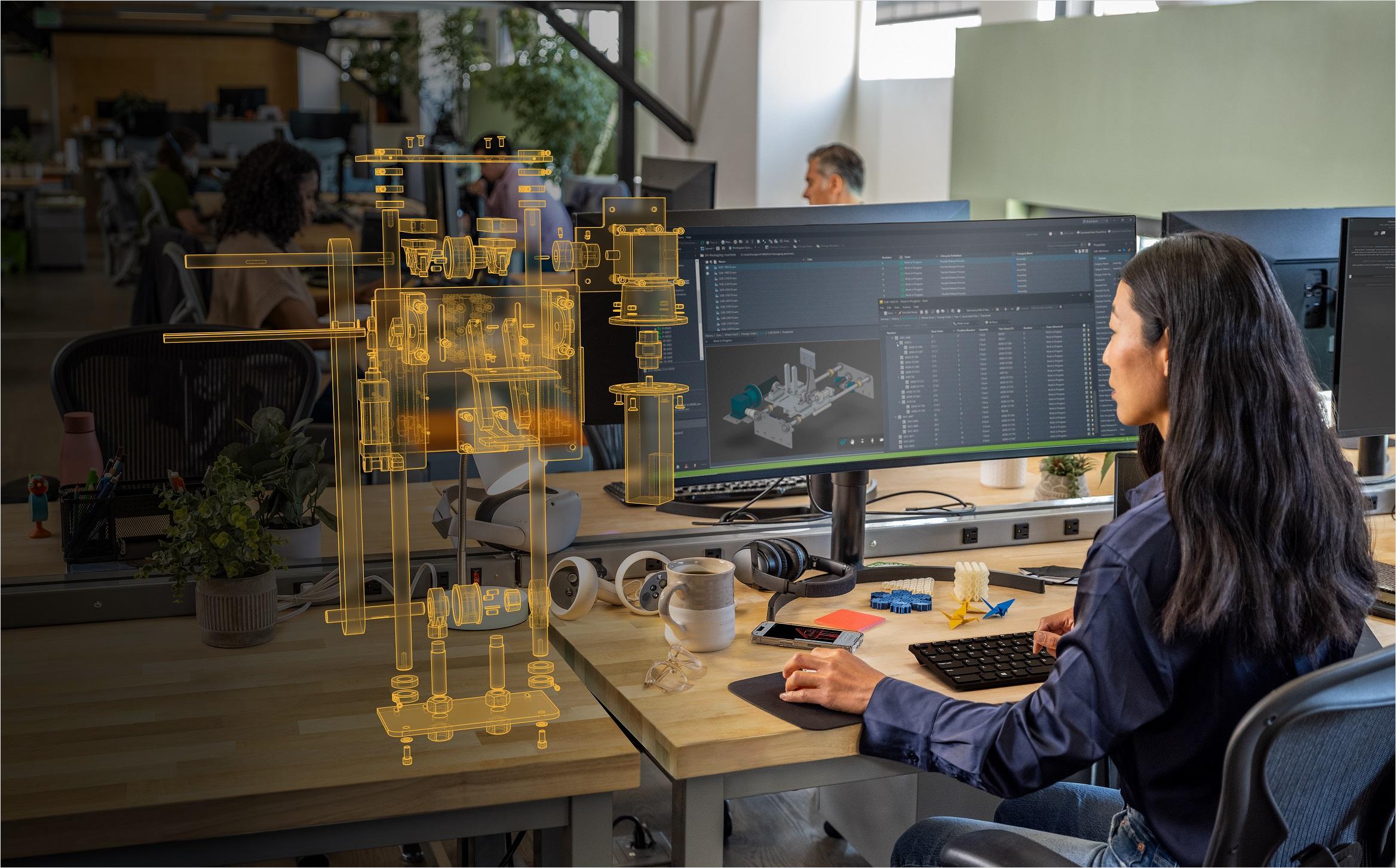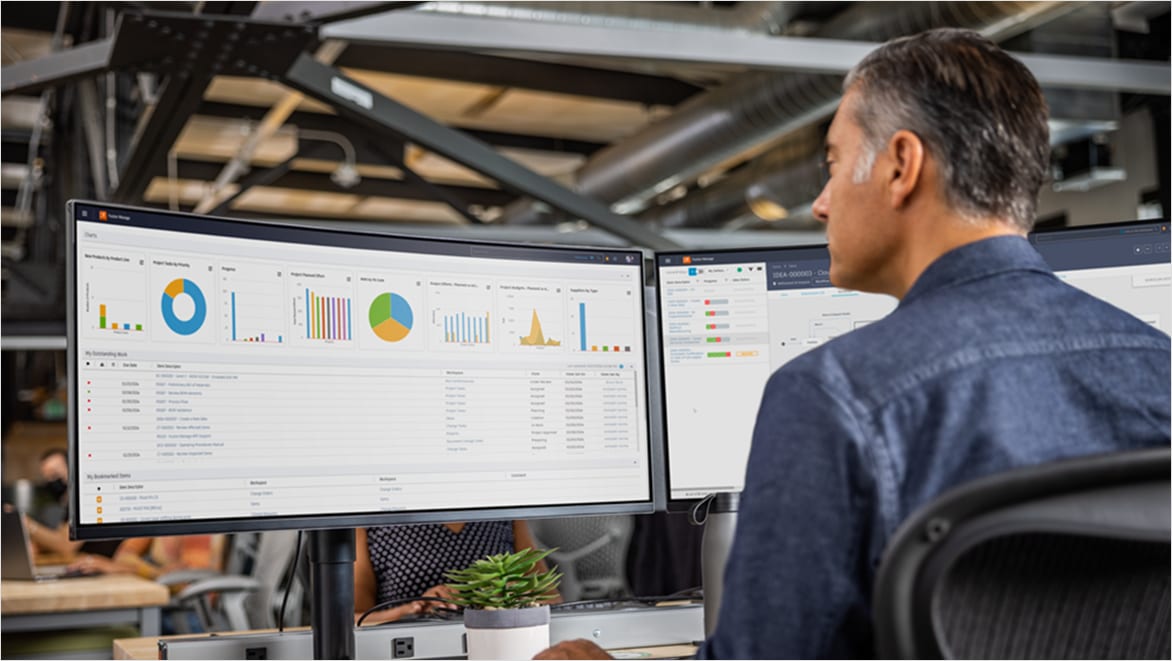& Construction

Integrated BIM tools, including Revit, AutoCAD, and Civil 3D
& Manufacturing

Professional CAD/CAM tools built on Inventor and AutoCAD
Product lifecycle management (PLM) is a strategic approach to managing the lifecycle of a product from inception, through engineering, design and manufacturing, to end of life. PLM integrates people, processes, business systems, and data to create a product information backbone for companies and their extended enterprise.
PLM software manages product-related data and streamlines the processes that are involved in the development, production, and support of products. This holistic approach gives stakeholders access to up-to-date information, allowing for better decision-making and collaboration throughout the product lifecycle.
PLM manages distinct product lifecycle stages that are crucial to successful product development. The concept and design phase involves conducting market research and using design tools to visualize product concepts and generate prototypes. During this stage, PLM also manages product requirements and new product introduction processes.
During the development and manufacturing stage, prototypes are refined, supply chain collaboration processes are integrated, and manufacturing plans are established with quality control measures put in place. Next, the launch and operations phases focus on strategic marketing, sales efforts, and managing quality to ensure customer satisfaction. The final stage, maintenance and end-of-life, provides post-sale support, including repairs, upgrades, and planning for responsible disposal and data archiving.
Integrating PLM with other digital thread technologies and business systems such as ERP and CRM creates a unified approach to product management. All aspects of the product lifecycle are connected, from initial concept to customer feedback and end-of-life disposal. This allows for better decision-making, enhanced efficiency, and improved product quality.
In manufacturing, product lifecycle management (PLM) provides the framework for managing the entire lifecycle of a product, providing seamless coordination among various departments and stakeholders. PLM improves efficiency by integrating design, production, and maintenance processes. This reduces time-to-market and minimizes costs associated with errors and rework.
Manufacturers can maintain a single source of truth for product data, maintaining consistency and accuracy throughout the production cycle. PLM also fosters innovation by facilitating collaboration and knowledge sharing, allowing teams to quickly adapt to market changes and customer demands. PLM also ensures that products meet quality and safety requirements, by suppporting industry standards and regulations. This helps manufacturers remain competitive and successful in the market.
Centralize your product-related data and processes to minimize time spent on low-value tasks, enhance product development agility, and streamline collaboration. By consolidating all your project data in one place, you can achieve greater efficiency and productivity.
With effective BOM management, you can document, track, and review every component in your product, prepare for manufacturing, and maintain data integrity throughout the entire product lifecycle.
Maintain control over revisions to designs, items, and records throughout the various phases of the product lifecycle. Facilitate efficient automation and documentation of revisions across departments for enterprise-wide visibility and traceability.
Set up project templates and standardize phase-gate milestones, deliverables, and tasks by product line, business unit, or product team. Accelerate the journey from concept to production.
Remain connected to your global supply chain around the clock with anytime, anywhere access to the information your extended organization needs for quoting, procurement, and supplier management.
Automate quality workflows, track and record changes, and analyze quality metrics to prevent issues. Minimize defects and non-conformities while enhancing product quality and reliability.
Implementing PLM offers numerous benefits to organizations, inlcuding:
PLM software enables better communication and collaboration among teams, departments, and stakeholders, ensuring everyone is on the same page throughout the product lifecycle.
By centralizing product data and processes, PLM software helps maintain consistency and accuracy, in turn leading to higher-quality products.
Efficient processes and better project management capabilities accelerate product development and quicker time to market.
Proper management of resources, reduction of errors and redundant processes can lead to significant cost savings.
PLM software helps in tracking and documenting compliance with industry standards and regulations, making sure that products meet necessary requirements.
By providing a complete view of the product lifecycle, PLM software encourages innovation through better insights and more informed decision-making.
By centralizing all product-related data, PLM software makes it easier to access, manage, and keep information up to date, leading to better data integrity.
PLM software provides complete traceability of the product lifecycle, from inception to retirement, which helps in understanding product performance and making improvements.
PLM systems help ensure that products are developed, managed, and supported efficiently during these lifecycle stages:
Both PDM and PLM are essential for efficient product development and management, but they serve different purposes and are typically used by different groups within an organization.
Product data management (PDM) focuses on managing the data related to product design, including CAD files, drawings, and documents. PDM provides version control, data security, and access control to ensure that the correct versions of files are used and changes are tracked accurately and efficiently. Typically, PDM is utilized by engineering and design teams to manage design data and facilitate collaboration, often integrating with CAD software for seamless data management.
On the other hand, product lifecycle management (PLM) encompasses a broader range of activities related to the entire lifecycle of a product, from initial concept through design, manufacturing, service, and end of life. PLM provides a comprehensive suite of tools for managing product-related processes such as project management, supply chain management, compliance, and quality control. It integrates data from various departments and systems to provide a complete view of the product lifecycle. Users range from product managers and engineers to supply chain managers and executives.
The introduction of CAD and CAM in the 60s and 70s ushered in the concept of PLM. As CAD and CAM technologies matured, the need for better integration became apparent.
As CAD and CAM technologies became more mature, the need for design and manufacturing integration became obvious. This led to the introduction of product data management (PDM) systems to centralize data and improve data management.
PLM emerged in the 1990s as companies became eager to manage the entire lifecyle of products. During this time, project management, collaboration tools, and workflow automation were introduced.
PLM solutions really started to grow in the 2000s, with features such as supply chain management, regulatory compliance, and customer feedback intergration.
In the 2010s, technologies like IoT, big data analytics, and cloud computing transformed PLM systems. Companies were now able to collect real-time datsa, perform advanced analytics, develop products in more agile method, and collaborate across global teams.
Today, PLM continues to mature with enhancements in AI, machine learning, and digital twins. These technologies improve predictive capabilities, automate tasks, and provide deeper insights into product performance.
Product lifecycle management (PLM) software has broad range of applications across various industries due to its ability to streamline processes, and improve collaboration and product quality. Here are some of the primary industry applications of PLM:
PLM helps consumer goods companies manage product development, package design, and regulatory compliance. It also helps streamline processes from concept to launch and manage customer feedback.
PLM helps manage the complex development process of vehicles. It also helps manage parts, configurations, and compliance with safety and health regulations.
PLM helps the aerospace indsutry manage intricate design specification, regulatory requirements, and lifecycle manage for aircraft and spacecraft.
PLM helps manage complex product designs, configurations, and maintenance schedules. It also helps ensure that products meet performance standards and regulatory requirements.
PLM helps manage the lifecycle of medical devices, ensuring compliance with stringent regulatory requirements, managing clinical trials, and streamlining the production process.
PLM helps manage building projects from design to construction to maintenance. Its helps make sure building codes and standards are adhered to and projects are managed efficiently.
PLM systems can face several challenges that can impact its effectiveness. First, they must seamlessly connect with enterprise systems such as PDM, ERP and CRM, and integration can be complex. In addition, due to the vast amount of information gathered throughout the product lifecycle, data governance, and security measures are a requirement.
Employees might also be reluctant to adopt new processes and technologies, so a PLM system should be configurable and easy to use. Some PLM systems can be costly to implement, posing a financial barrier. Even further, keeping up with rapid technological advancements and continuously updating PLM systems to leverage new capabilities can be demanding. Cloud-based PLM solutions can be less costly to implement and easier to adopt, while offering greater flexibility for evolving needs.
There are different PLM solution options to choose from. It requires careful planning to select the best option and even more planning to realize the benefits of PLM. It can be a challenge to understand the return on investment without first documenting baseline metrics before implementing the PLM solution.
The digital thread refers to the seamless flow of data throughout the entire lifecycle of a product, from initial design and development to manufacturing, maintenance, and eventual end of life. It connects various stages and systems, making sure that all relevant data is accessible and integrated, providing a comprehensive view of the product's history and current status. Here's how PLM supports the digital thread:
PLM provides a single source of truth for all product-related information, making sure that data is consistently available and accessible across the entire digital thread.
By capturing and documenting every change and decision throughout the product lifecycle, PLM ensures complete traceability, helping stakeholders to track the evolution of a product from conception to retirement.
PLM enhances cross-functional collaboration by allowing real-time sharing of information among teams, departments, and external partners, promoting improved communication and teamwork.
Integrated data analytics within PLM systems enable organizations to analyze product data, uncover trends, and make informed decisions based on insights gleaned from the digital thread.
PLM systems are designed to seamlessly integrate with other enterprise systems and tools, providing interoperability and smooth data exchange across various platforms.
PLM offers comprehensive lifecycle management capabilities that span from ideation to end-of-life. This helps ensure continuous updates and management of product data throughout its lifecycle.
Product lifecyle management (PLM) acts as a central hub connecting various departments to maintain seamless collaboration and data flow throughout the product lifecycle. Here's how PLM achieves this integration:
PLM facilitates the design and development of products by providing a unified platform for managing design data, revisions, and documentation. It enables engineering teams to collaborate effectively and access the latest design information.
PLM helps in planning and executing manufacturing processes by integrating design data with production schedules, work instructions, and BOMs (Bill of Materials). As a result, manufacturing teams can produce products accurately and efficiently.
PLM integrates with IT systems to provide a robust infrastructure for managing product data and workflows. It ensures data security, accessibility, and compatibility with other enterprise systems, such as Enterprise resource planning (ERP).
PLM automates quality workflows, tracks changes, and analyzes quality metrics to prevent issues. It helps maintain high product standards by making sure that quality control teams have access to relevant data and can monitor product performance.
PLM supports after-sales service by providing detailed product information, including design specifications and maintenance records. Service teams can use this information to troubleshoot issues, perform repairs, and provide better customer support.
PLM enhances supply chain management by providing real-time access to product data, supplier information, and procurement processes. Supply chain teams can manage inventory, coordinate with suppliers, and optimize logistics.
Product lifecycle management (PLM) plays a crucial role in sustainable and lean manufacturing by providing tools and processes that help organizations manage the environmental impact of their products throughout their entire lifecycle. By integrating sustainability metrics and practices into the design, manufacturing, and disposal phases, PLM systems help companies reduce waste, optimize resource usage, and maintain compliance with environmental regulations.
PLM also facilitates the tracking and reporting of sustainability goals, allowing organizations to make informed decisions that support eco-friendly initiatives and drive long-term sustainability. Product lifecycle management (PLM) plays a crucial role in sustainability by providing tools and processes that help organizations manage the environmental impact of their products throughout their entire lifecycle.
The future of product lifecycle management (PLM) is exciting, with digital technologies like AI, machine learning, IIoT, and cloud computing set to completely transform the landscape. These advancements will make PLM systems smarter and more predictive, giving us real-time data analytics, automated decision-making, and better teamwork across global teams. PLM will also increasingly focus on sustainability, making sure that products are developed with the environment in mind. As industries continue to grow and change, PLM will be more essential than ever for managing complex product lifecycles, driving innovation, and staying competitive in a fast-paced world.
Discover how Autodesk’s cloud PLM solution revolutionizes change management by automating revisions, ensuring comprehensive traceability, and empowering organizations to make data-driven decisions.
Learn how quality management through integrating design, manufacturing, and quality processes using PLM creates a closed-loop system, enhancing performance and reducing non-conformance costs.
While implementing a PLM solution may seem daunting, you can start seeing impressive results without implementing every workflow immediately.
PLM stands for product lifecycle management. It's a systematic approach to managing the series of changes a product goes through from its inception, design, and development, through its production, use, and disposal. PLM integrates people, processes, business systems, and information to streamline the lifecycle of products.
Key components include product data management (PDM), process management, project management, collaboration tools, and analytics.
PLM focuses on the management of product-related information and processes, while ERP (Enterprise Resource Planning) focuses on managing business operations such as inventory, finance, and human resources.
Yes, PLM can be integrated with ERP, CAD (Computer-Aided Design), CRM (Customer Relationship Management), and other enterprise systems to ensure seamless data flow and process integration.
The stages of product lifecycle management (PLM) typically include the following:
1. Concept and ideation: This stage encompasses idea generation, market research, and preliminary feasibility assessments. It involves brainstorming sessions, conceptual development, and the definition of the product's requirements and specifications.
2. Design and development: During this stage, detailed product designs are crafted using tools such as CAD (Computer-Aided Design). Prototypes are developed and tested, with iterative design adjustments made to enhance the product. This stage also involves conducting engineering analysis and validation.
3. Production and manufacturing: After finalizing the design, the product transitions into the production phase. This stage involves comprehensive planning, sourcing materials, executing manufacturing processes, assembly, and implementing quality control measures. It ensures the product is produced efficiently and adheres to quality standards.
4. Market launch: The product is introduced to the market during this stage. It involves marketing, sales, distribution, and customer support.
5. Growth: During the growth stage, the product gains market acceptance and demand increases. Efforts are made to optimize production, improve distribution, and enhance marketing campaigns to maximize sales.
6. Maturity: The product reaches peak market penetration in the maturity stage. Sales stabilize, and focus shifts to maintaining market share, optimizing operations, and extending the product's lifecycle through updates or enhancements.
7. Decline: The product enters the decline stage as market demand decreases, often due to technological advancements, changing customer preferences, or increased competition. Strategies are developed for product discontinuation, cost reduction, and transitioning customers to newer products.
8. Retirement:The final stage involves phasing out the product from the market. This includes managing inventory, providing support for existing customers, recycling or disposing of the product, and transitioning to new product offerings.
PLM systems streamline the management of BOM by providing a centralized platform that integrates all product data, including CAD models and specifications. This ensures the BOM remains accurate, current, and easily accessible to all stakeholders involved in product development. PLM systems also facilitate version control and change management, enabling teams to track updates and maintain consistency throughout the BOM. By optimizing BOM management, PLM systems improve collaboration, minimize errors, and enhance efficiency in manufacturing and procurement processes.
PLM solutions improve collaboration across teams by providing a centralized platform where all product data is accessible, so that everyone is working with the most up-to-date information. This helps facilitates seamless communication and coordination among design, engineering, manufacturing, and marketing teams, leading to more efficient workflows and improved product development outcomes.
When choosing a product lifecycle management software solution, consider the following top three factors:
1. Functionality and features: Evaluate whether the PLM software offers the necessary tools and features to support your specific product lifecycle processes. This includes capabilities for design management, collaboration, data integration, version control, change management, and compliance tracking.
2. Integration capabilities: The software should integrate seamlessly with other systems in your organization, such as ERP, CRM, CAD, and digital thread technologies. Effective integration ensures a cohesive approach to managing product data across different departments, enhancing efficiency and reducing data silos.
3. Scalability: Make sure the software can accommodate your company's growth and evolving needs. It should be flexible enough to adapt to changes in processes, workflows, and organizational structure. Look for a solution that can easily scale with your product portfolio and support future expansion without requiring significant changes or investments.
The four stages of the product lifecycle are introduction, growth, maturity, and decline.
Cloud PLM offers greater flexibility and scalability compared to onsite PLM, allowing teams to access and collaborate on product data from anywhere, at any time, without the need for extensive IT infrastructure. Cloud PLM systems also typically provide automatic updates and enhanced security measures, reducing maintenance efforts and ensuring that the latest features and protections are always in place.





















